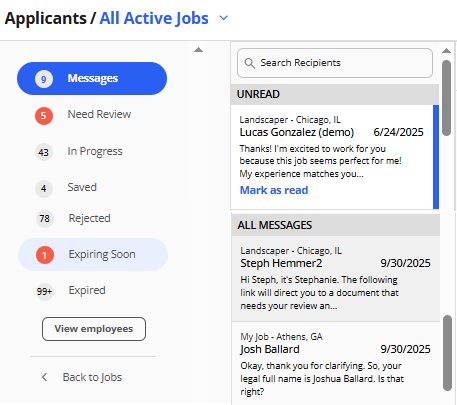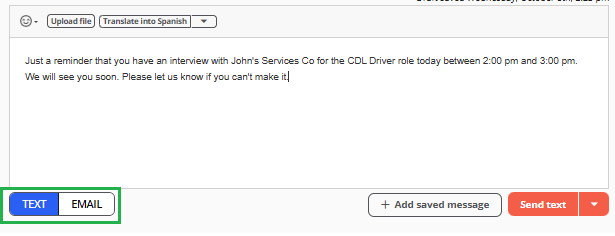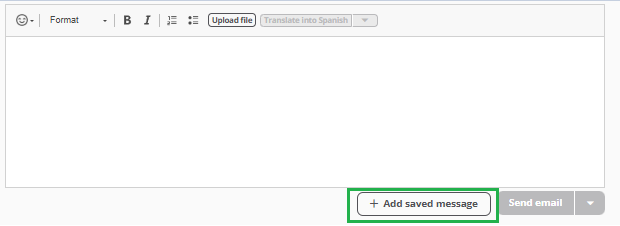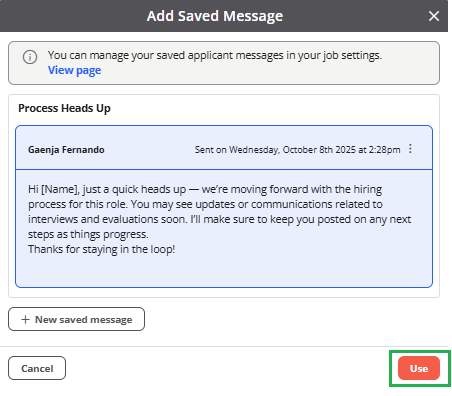Messaging Applicants with Team Engine
Reaching applicants quickly is key to hiring success. Since most people don’t answer unknown calls, texting and emailing are the best ways to connect. Team Engine makes this easy by combining text, email, and phone communication all in one place.
📨 Messages Tab Overview
Your Messages tab shows every text and email conversation with applicants.
- Unread: Messages waiting for your reply
- All Messages: Everything you’ve already viewed or replied to
You can reply directly from this tab, just like texting on your phone. Choose to send your message by text or email — both options appear in the same conversation thread so your team can stay in sync.

✉️ Email vs. Text
Texting is the fastest way to reach candidates. Almost every text is read within seconds.
Team Engine will automatically text applicants who have opted in; others will receive emails.
Switch between email and text anytime by clicking the channel button at the bottom of your message window. Both types of messages stay together in one conversation for easy tracking.

🧾 Saved Messages
Speed up your outreach with saved messages:
- Click Use next to a suggested message to send it right away
- Edit any template to fit your tone
- Add your own saved messages for common questions or updates




📎 Sending & Receiving Files
You can attach files to your messages by clicking Upload File.
Applicants can also send files back to you, which appear in the message thread and their Documents tab.
File details:
- Size limit: 25 MB
- Accepted types: PDFs, Word docs, spreadsheets, images, videos, audio
- You’ll now see most image files (like GIFs, SVGs, WEBPs) displayed right in the thread
- Note: You can receive GIFs, but can’t send them by text
⚠️ Text Message Limits & Delivery
Text messages must be under 670 characters.
Longer messages can fail or be filtered by phone carriers.
If your message is longer, use email instead to make sure it’s delivered.
Sometimes, messages fail to send. Here are common reasons:
| Reason | What It Means | What You Can Do |
|---|---|---|
| Message too long | Over 670 characters | Shorten or send by email |
| Filtered by carrier | Message looked like spam (too many links, emojis, or all caps) | Keep it short and simple |
| Invalid phone number | Number is wrong or inactive | Double-check the contact info |
| User opted out | Candidate replied “STOP” or “UNSUBSCRIBE” | They’ll need to reply “START” or “YES” to receive texts again |
If a message fails, you can resend it or switch to email.
💬 Replying from Email
You can turn on email notifications to get alerts when candidates message you.
If you reply to that email, your response will automatically go to the applicant through Team Engine — whether it was a text or email originally.
👉 Important: Replies to “new applicant shared” or “survey” notifications go to the Team Engine Support team, not the applicant. Always reply directly in Team Engine for candidate messages.
💡 Messaging Tips
- Use the applicant’s name and keep messages short
- Be friendly but professional
- Always end with a clear next step (e.g., “Please reply with your availability”)
- Respond quickly — fast replies increase your chances of hiring them
What Now?
Messaging is valuable because it allows employers to reach out to applicants in new ways that significantly improve response time. Texting applicants has already proven itself to be incredibly efficient at getting responses from candidates. Now that you know the ins and outs of messaging with Team Engine, start engaging with applicants so you can start filling roles.
